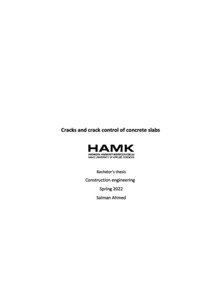Cracks and crack control of concrete slabs
Ahmed, Salman (2022)
Ahmed, Salman
2022
All rights reserved. This publication is copyrighted. You may download, display and print it for Your own personal use. Commercial use is prohibited.
Julkaisun pysyvä osoite on
https://urn.fi/URN:NBN:fi:amk-2022060816508
https://urn.fi/URN:NBN:fi:amk-2022060816508
Tiivistelmä
A reinforced concrete slab is a very important structural element in the building which is constructed to provide a flat surface. To feel safe and comfortable, the slab should fulfill its intended design requirements. The idea for the thesis arose during my summer job where I was fixing cracks in concrete slab intermediate floors.
The primary goal of this thesis is to conduct a case study of the reinforced slab and to investigate all possibilities that can cause early-age cracking on the slab, such as material properties, construction procedures, external loading conditions, and environmental conditions. In addition, the goal is to perform a reinforcement design for both Ultimate Limit State (ULS) and Serviceability Limit State (SLS) as well as to deduce whether it is possible to control cracking by calculating crack widths according to EC2. Furthermore, particular attention is paid to shrinkage and creep and their role in the designing process.
A result of this bachelor’s thesis showed that practical calculation methods for the Ultimate Limit States (ULS) and Serviceability Limit States (SLS) fulfilled the design requirements of Eurocodes. The influence of temperature, at the time of casting and curing the slab, causes the loss of moisture from the concrete slab and results in a reduction in volume, so drying out occurs from the surface.
Therefore, the surface layer of the slab is cracked, due to temperature differences.
In conclusion, it was suggested to use the Epoxy injection method after the drying period to seal and bond inside the crack.
The primary goal of this thesis is to conduct a case study of the reinforced slab and to investigate all possibilities that can cause early-age cracking on the slab, such as material properties, construction procedures, external loading conditions, and environmental conditions. In addition, the goal is to perform a reinforcement design for both Ultimate Limit State (ULS) and Serviceability Limit State (SLS) as well as to deduce whether it is possible to control cracking by calculating crack widths according to EC2. Furthermore, particular attention is paid to shrinkage and creep and their role in the designing process.
A result of this bachelor’s thesis showed that practical calculation methods for the Ultimate Limit States (ULS) and Serviceability Limit States (SLS) fulfilled the design requirements of Eurocodes. The influence of temperature, at the time of casting and curing the slab, causes the loss of moisture from the concrete slab and results in a reduction in volume, so drying out occurs from the surface.
Therefore, the surface layer of the slab is cracked, due to temperature differences.
In conclusion, it was suggested to use the Epoxy injection method after the drying period to seal and bond inside the crack.
